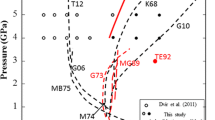Abstract
Liquidus phase relations in the system diopside–kalsilite–forsterite–quartz with 3 wt% F were examined at 1 bar and the locations of important invariant points were determined at 18 kbar. At all pressures within this range a large liquidus field for fluorphlogopite (Phl) exists, and has a large influence on both melting and fractionation processes. One eutectic point was found to the silica-rich side of the plane Lc–Fo–Di at Di1Ks30Fo2Qz67, where a melt coexists with San, Qz, Phl and Di at 840 °C and 1 bar. Another eutectic point must exist in the silica-poor part of the system because the phase topology determines that thermal barriers must exist. At this point a feldspathoid, either Lc or Ks, must coexist with Fo, Phl and a Ca-bearing phase such as Di. The exact location and phase assemblage were not determined, but the equilibrium melt must have a composition rich in Di (>29 wt%) and extremely poor in Qz (<8 wt%). The composition of the first eutectic moves towards lower SiO2 contents with increasing pressure (Di3Ks40Fo1Qz56 at 18 kbar), whereas the second does not exist at 18 kbar due to the disappearance of Lc as a stable liquidus phase. Liquids which coexist with mafic minerals such as En, Fo, Phl and Di are important for the genesis of potassium-rich mafic rocks by partial melting in the mantle and for the early stages of fractional crystallisation. The equilibrium melt at the invariant point Fo + En + Phl + Di + L at 1125 °C is very poor in Fo and Di components at atmospheric pressure (Di5Ks37Fo5Qz53), whereas at 18 kbar the melt contains large amounts of Fo and Di (Di19Ks31- Fo28Qz21), and has a composition close to that of natural lamproites. Kamafugites do not correspond to melts in this system under any of the studied conditions, and appear to require CO2 in the source. Fractionation processes from primitive potassic basanite melts are controlled principally by the size (and not the mere presence) of the liquidus phase field for phlogopite: at high pressures where the Phl field is large, olivine is eliminated early from the fractionating assemblage and Cpx + Phl fractionation may lead to relatively silica-rich rock differentiates such as trachytes. At low pressures, extensive olivine and restricted Phl crystallisation prevents silica enrichment in the melt, resulting in phonolitic differentiates. Later crystallisation of alkali feldspar accentuates the trends laid down in the early stages of fractionation.
Similar content being viewed by others
Author information
Authors and Affiliations
Additional information
Received: 2 February 1999 / Accepted: 14 October 1999
Rights and permissions
About this article
Cite this article
Melzer, S., Foley, S. Phase relations and fractionation sequences in potassic magma series modelled in the system CaMgSi2O6-KAlSiO4-Mg2SiO4-SiO2-F2O−1 at 1 bar to 18 kbar. Contrib Mineral Petrol 138, 186–197 (2000). https://doi.org/10.1007/s004100050017
Issue Date:
DOI: https://doi.org/10.1007/s004100050017




